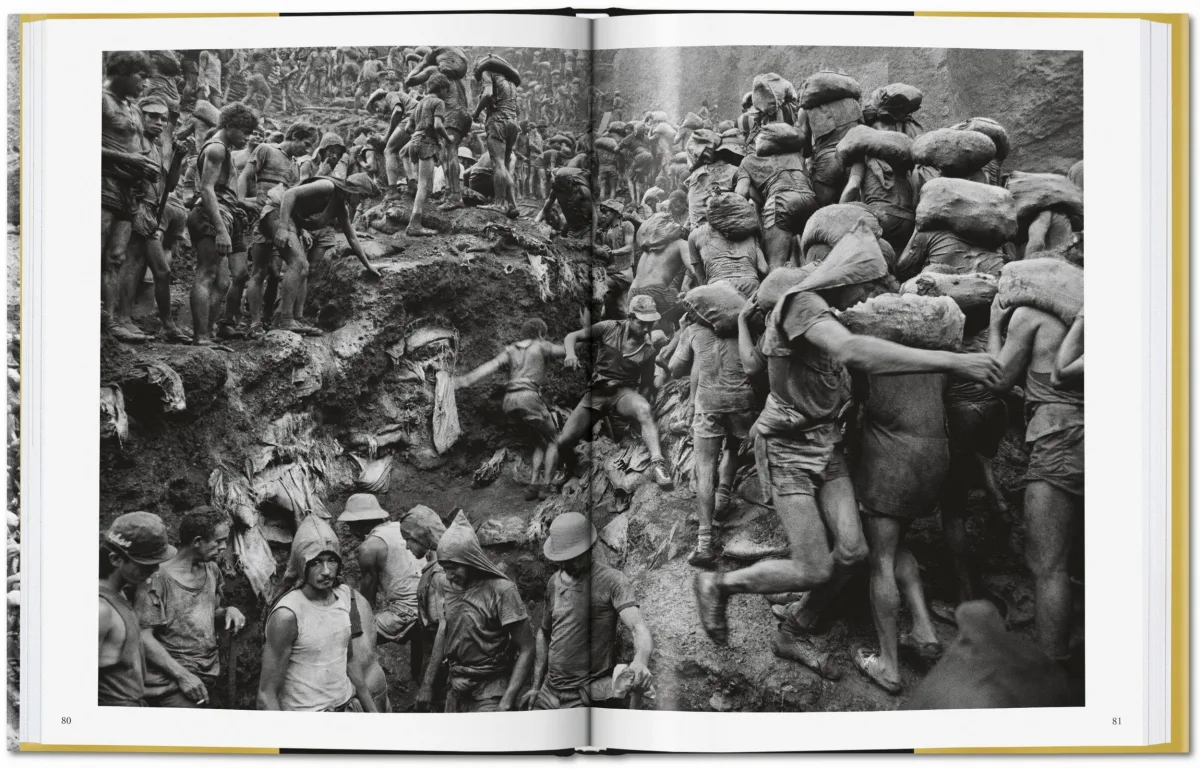Sebastião Salgado. Gold
60Edition: Multilingual (English, French, German)Availability: August 3, 2024Also available in a signed and limited Collector’s Edition

Sebastião Salgado. Gold
60Salgado's dramatic account of the Brazilian gold rush
Haunting black-and-white photographs of biblical dimension
“What is it about a dull yellow metal that drives men to abandon their homes, sell their belongings and cross a continent in order to risk life, limbs and sanity for a dream?” – Sebastião Salgado
When Sebastião Salgado was finally authorized to visit Serra Pelada in September 1986, having been blocked for six years by Brazil’s military authorities, he was ill-prepared to take in the extraordinary spectacle that awaited him on this remote hilltop on the edge of the Amazon rainforest. Before him opened a vast hole, some 200 meters wide and deep, teeming with tens of thousands of barely-clothed men. Half of them carried sacks weighing up to 40 kilograms up wooden ladders, the others leaping down muddy slopes back into the cavernous maw. Their bodies and faces were the color of ochre, stained by the iron ore in the earth they had excavated.
After gold was discovered in one of its streams in 1979, Serra Pelada evoked the long-promised El Dorado as the world’s largest open-air gold mine, employing some 50,000 diggers in appalling conditions. Today, Brazil’s wildest gold rush is merely the stuff of legend, kept alive by a few happy memories, many pained regrets—and Sebastião Salgado’s photographs.
Color dominated the glossy pages of magazines when Salgado shot these images. Black and white was a risky path, but the Serra Pelada portfolio would mark a return to the grace of monochrome photography, following a tradition whose masters, from Edward Weston and Brassaï to Robert Capa and Henri Cartier-Bresson, had defined the early and mid-20th century. When Salgado’s images reached The New York Times Magazine, something extraordinary happened: there was complete silence. “In my entire career at The New York Times,” recalled photo editor Peter Howe, “I never saw editors react to any set of pictures as they did to Serra Pelada.”
Today, with photography absorbed by the art world and digital manipulation, Salgado’s portfolio holds a biblical quality and projects an immediacy that makes them vividly contemporary. The mine at Serra Pelada has been long closed, yet the intense drama of the gold rush leaps out of these images.
This book gathers Salgado’s complete Serra Pelada portfolio in museum-quality reproductions, accompanied by a foreword by the photographer and an essay by Alan Riding.
INSTITUTO TERRA
Founded in 1998 at Aimorés in the state of Minas Gerais, Instituto Terra is the culmination of Lélia Wanick Salgado and Sebastião Salgado’s lifelong activism and work as cultural documentarians. Through a scientific program of planting and raising saplings, the organization has performed a miraculous reforestation of the once infertile region and furthered the Salgados’ mission of reversing the damage done to our planet. TASCHEN is proud to reach carbon zero status through our continued partnership.
Also available in a signed and limited Collector’s Edition
The photographer and author
Sebastião Salgado began his career as a professional photographer in Paris in 1973 and subsequently worked with the photo agencies Sygma, Gamma, and Magnum Photos. In 1994, he and his wife Lélia Wanick Salgado created Amazonas Images, which is today their studio, and exclusively handles his work. Salgado’s photographic projects have been featured in many exhibitions as well as books, including Sahel. L’Homme en détresse (1986), Other Americas (1986), Terra (1997), Migrations (2000), The Children (2000), Africa (2007), Genesis (2013), The Scent of a Dream (2015), Kuwait. A Desert on Fire (2016), Gold (2019) and Amazônia (2021).
The contributing author
Alan Riding is a Brazilian-born British author and former long-time foreign correspondent for The New York Times. Having served as the paper’s bureau chief in Mexico, Brazil, and France as well as its European arts correspondent, he is now writing for the theatre. A resident of Paris like Sebastião Salgado, the two have been friends and collaborators since the early 1980s.
The editor and art director
Lélia Wanick Salgado studied architecture and urban planning in Paris. Her interest in photography started in 1970. In the 1980s, she began to conceive and design the majority of Sebastião Salgado’s photography books and all of the exhibitions of his work.
Sebastião Salgado. Gold
Hardcover, 24.8 x 33 cm, 2.20 kg, 208 pagesISBN 978-3-8365-7508-9
Edition: Multilingual (English, French, German)5.0







